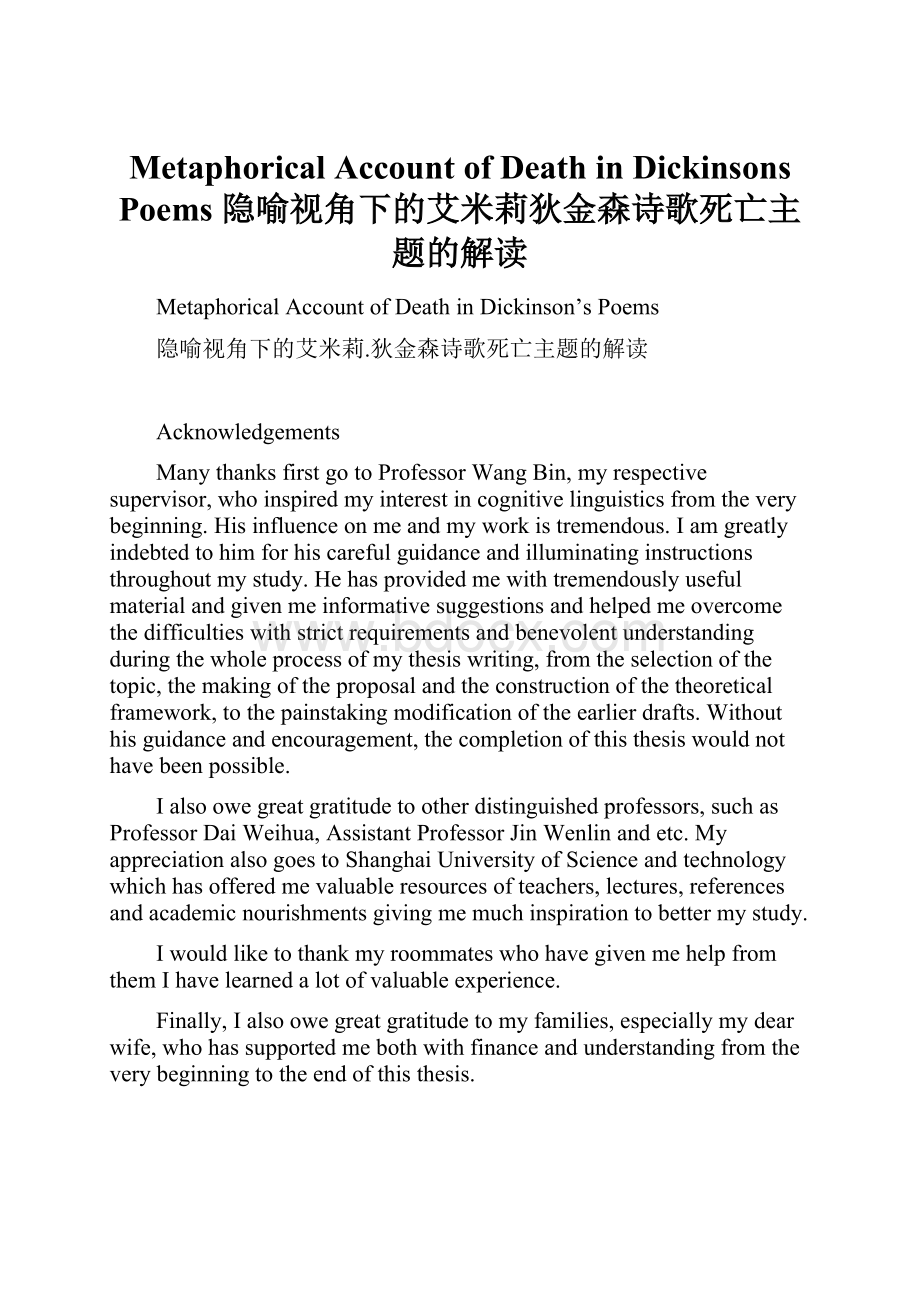Metaphorical Account of Death in Dickinsons Poems隐喻视角下的艾米莉狄金森诗歌死亡主题的解读.docx
《Metaphorical Account of Death in Dickinsons Poems隐喻视角下的艾米莉狄金森诗歌死亡主题的解读.docx》由会员分享,可在线阅读,更多相关《Metaphorical Account of Death in Dickinsons Poems隐喻视角下的艾米莉狄金森诗歌死亡主题的解读.docx(51页珍藏版)》请在冰豆网上搜索。

MetaphoricalAccountofDeathinDickinsonsPoems隐喻视角下的艾米莉狄金森诗歌死亡主题的解读
MetaphoricalAccountofDeathinDickinson’sPoems
隐喻视角下的艾米莉.狄金森诗歌死亡主题的解读
Acknowledgements
ManythanksfirstgotoProfessorWangBin,myrespectivesupervisor,whoinspiredmyinterestincognitivelinguisticsfromtheverybeginning.Hisinfluenceonmeandmyworkistremendous.Iamgreatlyindebtedtohimforhiscarefulguidanceandilluminatinginstructionsthroughoutmystudy.Hehasprovidedmewithtremendouslyusefulmaterialandgivenmeinformativesuggestionsandhelpedmeovercomethedifficultieswithstrictrequirementsandbenevolentunderstandingduringthewholeprocessofmythesiswriting,fromtheselectionofthetopic,themakingoftheproposalandtheconstructionofthetheoreticalframework,tothepainstakingmodificationoftheearlierdrafts.Withouthisguidanceandencouragement,thecompletionofthisthesiswouldnothavebeenpossible.
Ialsoowegreatgratitudetootherdistinguishedprofessors,suchasProfessorDaiWeihua,AssistantProfessorJinWenlinandetc.MyappreciationalsogoestoShanghaiUniversityofScienceandtechnologywhichhasofferedmevaluableresourcesofteachers,lectures,referencesandacademicnourishmentsgivingmemuchinspirationtobettermystudy.
IwouldliketothankmyroommateswhohavegivenmehelpfromthemIhavelearnedalotofvaluableexperience.
Finally,Ialsoowegreatgratitudetomyfamilies,especiallymydearwife,whohassupportedmebothwithfinanceandunderstandingfromtheverybeginningtotheendofthisthesis.
艾米莉.狄金森死亡诗歌的概念隐喻分析与解读
摘要
C.Lewis曾说过,隐喻是诗歌的生命,是诗人的主要文本和荣耀。
没有隐喻,也就没有诗歌。
作为美国最伟大的女性诗人,艾米莉.狄金森的诗歌充分的反应了这一观点。
本篇论文依据莱考夫和约翰逊的概念隐喻理论为理论基石和研究视角,对女诗人的死亡诗进行认知解读;从艾米莉诗歌创造的实践和对死亡的哲学思考,作者从中得出文化创造是人类超越肉体死亡的一种方法,对于艾米莉.狄金森来说,她的不朽或永恒就在于她的诗歌里。
因此我们就不难理解她终生隐遁生活,其目的有二,其一是为了腾出更多的时间与经历去进行诗歌创造;其二是隐遁使她的艺术生命获得了再生。
概念隐喻贯穿全文,为本篇论文的理论红线。
考虑到诗人的诗歌浩如烟海,作者仅对诗人的典型作品进行认知解读,并把她的死亡诗歌划分为三类,分别是对死亡的恐惧与彷徨,直面死亡以及超越死亡。
这样做的是因为诗人对死亡的认识是一个动态的上升的过程,其目的是通过步步分析最终得到诗人的理想境地—超越死亡获得永生。
在具体分析研究中,作者从她的诗歌中提炼出几个基本的概念隐喻,分别是死亡是一次痛苦的旅程,死亡是人,死亡是睡眠,死亡是黑夜,死亡是隐遁,圆周是永生等。
并分析这些概念隐喻的系统性和连贯性,进而得到对诗人死亡哲学的一个完整的充分的认识,以及对这些死亡诗歌有一个新的理解。
本篇论文共有五章,第一章引言,重点是综述国内外对诗人死亡诗歌的研究特点及方法。
并提出自己的视角-概念隐喻视角;第二章是文献综述。
第三章分析研究死亡诗歌里出现的有关死亡的概念隐喻。
第四章承接第三章,分析研究死亡隐喻的连贯性和系统性,目的是对诗人死亡哲学有个比较完整的认识,第五章是结论部分,并指出本篇论文的不足与未来的研究工作。
关键词:
概念隐喻死亡诗歌认知分析连贯性
Abstract
ThisthesisgivesadetailedanalysisofDickinson’sdeathpoemsfromconceptualmetaphortheory.Basedonthepoetess’swritingexperienceandphilosophyofdeath,theauthorconcludesthatculturalcreationisawaytoovercomedeath.ToEmilyDickinson,herimmortalityoreternityliesonherpoetry.Therefore,wecansaythatherseclusioninherlaterlifeismainlyforsavingtimetowritepoemsandmakingherartlifeimmortal.
Asthemainthreadthatrunsthroughthethesis,conceptualmetaphortheoryisamilestoneinthefieldofmetaphorresearch.ThetraditionaltheoryrepresentedbyAristoleisconfinedtotherhetoricfield.Thisthesiswilljustgiveaglimpseofmetaphorhistory.Indealingwiththepoetess’sdeathpoems,theauthorwillanalyzesomerepresentativesofthem.Moreover,thethesiswillcategorizethesedeathpoemsinto3kinds:
poemsoffearingdeath,facingdeathcalmlyandovercomgingdeathbasedherchangingattitudetowarddeath.Theauthordrawsaconclusionthatthepoetess’sidealistoovercomedeaththroughmeansofpoetrywritingafterastepwiseanalysis.
AfteracomprehensivestudyofdeathmetaphorsinEmilyDickinson’spoems,theauthorabstractsseveralfundamentalconceptualmetaphorsineachof3kindsofpoemssuchasDEATHISAPAINFULDEPARTURE,DEATHISAPERSON,DEATHISSLEEP,DEATHISNIGHTandCIRCUMFERENCEISIMMORTALITY,DEATHISSECLUSIONandsoon.ThentheauthoranalyzesthemcombiningwithEmilyDickinson’slifeexperience.Finally,coherenceandsystematicityofthesemetaphorsarestudiedwithaviewtogettingacomprehensiveknowledgeofthepoetess’sphilosophyofdeathandprovidinganewperspectivetounderstandthesedeathpoemsaswell.
Thisthesisisdividedinto5chapters.Inchapterone,theauthorwillgiveabriefoverviewofmetaphorstudy,EmilyDickinson’sdeathpoemsandtherelationamongdeath,literatureandmetaphor.Inchapter2,theauthorreviewsthehistoryofEmilyDickinson’sdeathpoemstudy.Inchapter3,deathmetaphorsinEmilyDickinson’spoemsareextractedandanalyzed.Inchapter4,coherenceandsystematicityofdeathmetaphorsarestudiedtogetabetterunderstandingofthepoetess’sviewondeath.Inchapter5,theauthormakeaconclusionofthisthesisandpointsoutsomelimitationsandfuturetodo.
KeyWords:
conceptualmetaphor;EmilyDickinson;cognitiveapproach;poetry;coherenceandsystematicity
Chapter1introduction
1.1Anoverviewstudyofmetaphor
Traditionally,metaphoristakenasafigureofspeechandisregardedasaneffectiverhetoricaldevicetopersuadepeople.ViewpointsofthisrhetoricalschoolcanbetracedbacktoAristotleandCicero.SuchtheoriesincludeAristotle’scomparisontheory,Quintilian’ssubstitutiontheoryandBlack’sinteractiontheory.Thesetheoriestreatedmetaphorjustarhetoricaldevice.
WiththepublicationofMetaphorsweliveby(1980,Lakoff&Johnson),metaphorshavebeenstudiedmainlyfromcognitiveperspective.LakoffandJohnsonaswellastheircolleagueshavethoughtthatmetaphorshavenotonlyrhetoricalfunctionbutalsocognitivefunction.Theybelievedthatnotonlythehumanconceptualsysteminvolvesintheprocessing,understandingandmakinguseofmetaphor,buttheconceptualsystemitselfismetaphoricallystructured.Thus,metaphorisfoundtobepervasiveinoureverydaylife,inlanguageandmostimportantly,inthoughtandaction.Inotherwords,metaphorplaysabasicroleindefiningthewayweperceivetheworld,thewaywethinkandacttothatperceivedworld.Thereasonwhymetaphorsinlinguisticexpressionsarepossibleisthattherearemetaphorsinaperson’sconceptualsystem(Lakoff&Johnson,1980:
6).Theirtheoryonmetaphorisknownasconceptualmetaphortheory.
1.2Metaphorandpoetry
Metaphorisallessentialcomponentofpoetryanditisabasicbuildingblockthatmakespoetry.Andithaslongbeenconsideredasamostimportantdeviceofthepoeticimaginationanditisthelifeprincipleofpoetryandtreatedasthepoet’smaintextandhonor.G.Bachelardsaidthatthebrainofapoetisactuallyandcompletelyacontainerholdingasetofmetaphoricalsyntax.AristotleoncesaidintheendofPoetics,“Butthegreatestthingbyfaristobeamasterofmetaphor,anditisonethingthatcan’tbelearned”andintheRhetoric,“Frommetaphorwecanbestgetholdofsomethingfresh,”and“Metaphormoreovergivesstyleclearness,charmanddistinctionasnothingelse”(W.Shys.Robert).Andthegreatpoetsthemselvespaidgreatattentiontotheroleofmetaphorinthepoetry.RobertFrostremarked,“TherearemanyotherthingsIhavefoundmyselfsayingaboutpoetry,butthebriefestoftheseisthatitismetaphor,sayingonethingintermsofanother.”Poetsfrequentlyuseitnotonlytosimulatethereadertothinkandimagine,butalsoprovokeawiderangeofemotionsandpoetsusemetaphortocreatebeautifulandassociativeimagerytocommunicateprofoundmeaning.Withoutmetaphorpoetrywouldbeuninterestingjargon,withoutmetaphorthereaderwouldnotbemovedemotionally,withoutmetaphorpoetrywouldbeextremelyshallow.Shallowpoetryisperhapsoneofthemostpurposelessformsofwritingavailable.Sotosumup,wecanknowthatthefunctionsofmetaphorinthepoetryaretomakepoemsmorebeautiful,novelandinteresting,tocrystallizeandevenvisualizetheabstractconceptsthusavoidingwaterinessandmonotonousness.Inaword,metaphoristhelifeofpoetry.
Dickinson’sstarkstyle,herambiguouspunctuationandcapitalization,hervariantwordchoicesandmultipleversionsofpoems,andherpracticeofexpungingclearlyhistoricalreferencesfromherpoetry,allcontributetocreatingpoemsthatareopentovarying,sometimescontradictory,interpretationsthatperplex,startle,andamazeherreaders.Besidethis,themostsalientfeatureisherfrequentuseofmetaphors,whicharenovelandseemsquitestrangetoherreaders.Shebelievesthatmindcanknoweverything.Emily’smindisanalogical,thatistosay,mostoften,theboundaryofthepoemisnotaparticularsceneorsituationbutthefigureofanalogyasitmovesfromscenestoscenes.Sheoftenemployedatleasttwothingsorideasatoncetocreateacomplicatedrelationshipbetweentwoideasorimages.Herso-calledabstractimagesaregroundedinherphysicalandintellectualexperienceoftheworldandtheuniversearoundher.Theconstructivepoweroftheconceptualmetaphorcanenablehertocreateherindividualizedworld.Howevereverythinghastwosides.Thepoet’sfrequentuseofmetaphor,ononehand,canmakepoemsmorenovelandinterestingandhelpthereadertakesomethingabstractandputitintoconcreteterms,thenfigureoutwhatmeaningthepoetisintendingtoconvey.Itallowsthemtogobeyondtheoutwardviewofthetextandfurtherintotheinternalstructureofthepoemtograspitsdeepmeaning.Butontheother,theuseofmetaphorcanadddifficultytounderstandingofthepoems,becauseonemetaphorhasvariousinterpretationswhichrunparallelwithvariousunderstandingofasinglepoem.Soaproperunderstandingofmetaphorsiscrucialtounderstandingherpoems.
1.3Deathandliterature
InWesternhumanism,death,astheoppositeoflife,hasirreplaceablevalue.Soitiscommonthatdeathbecomestheeverlastingsubjectthewesternliterature.Itcanbesaidthatwithoutmuchconsiderationofdeath,thereisno